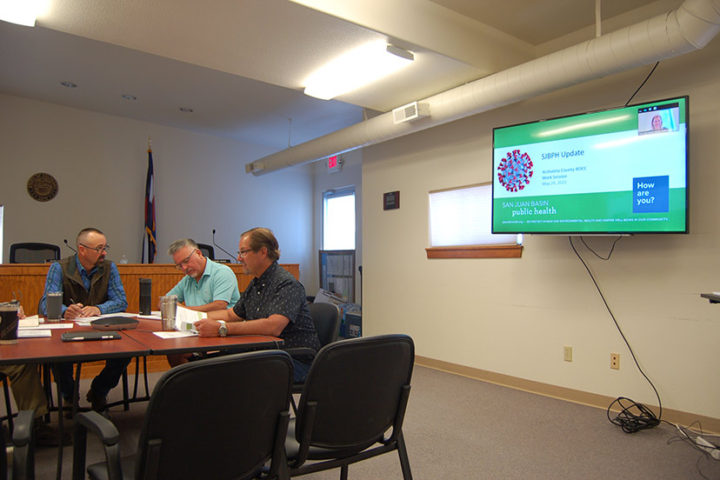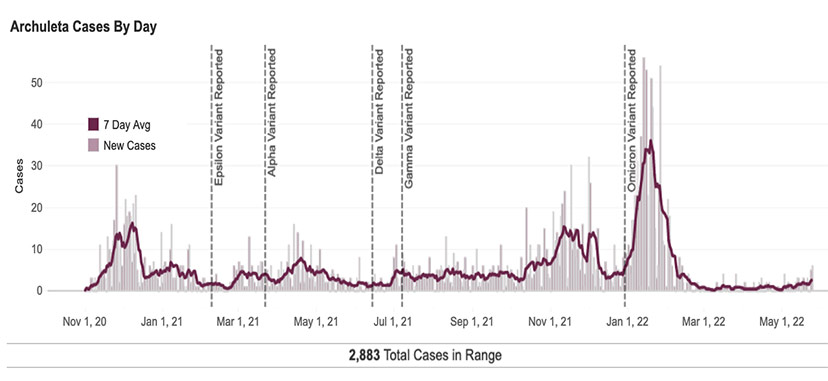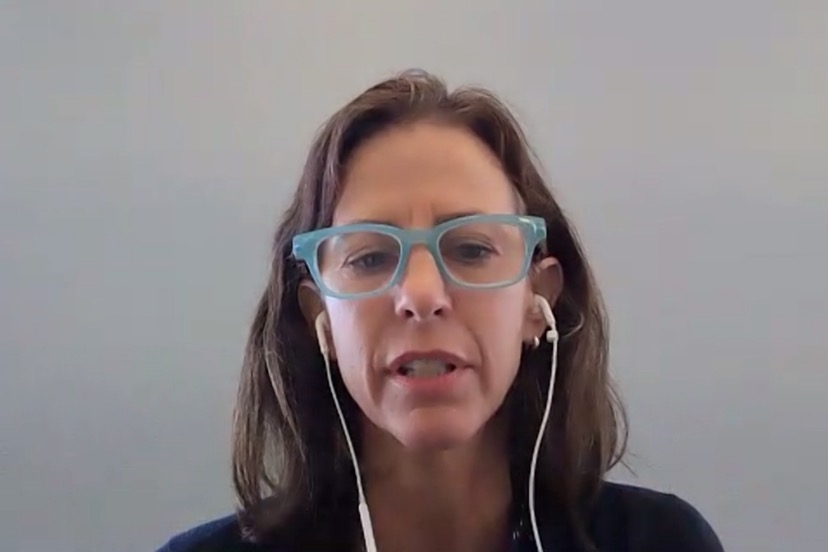PHOTO: San Juan Basin Public Health Executive Director Liane Jollon, in a ZOOM press conference, October 30, 2020.
As mentioned in Part One, the Archuleta Board of County Commissioners got an earful about community health on Tuesday, May 24 at their morning work session. The first presentation concerned a ‘Nutrition Security Health Equity Assessment’ which, as I understood the discussion, is part of a two-year effort — or a longer effort? — to ensure access to nutritious food and health care, for individuals and families currently struggling with those issues.
The second presentation took place via Zoom, delivered by San Juan Basin Public Health Executive Director Liane Jollon. As many Daily Post readers already know, the Archuleta BOCC convened a citizens task force last August to investigate the feasibility of ending the joint venture between La Plata County and Archuleta County, to provide public health services through San Juan Basin Public Health.
For several months prior to convening the task force, the Archuleta BOCC had seemed, during public discussions, to be favoring a divorce.
Archuleta County is legally required to provide public health services within its boundaries. For the past 70 years or so, those necessary services — including testing, education, counseling, and enforcement around a range of public health concerns — have been provided by San Juan Basin Health Department, now known as San Juan Basin Public Health.
The citizens task force provided the Archuleta BOCC with some information a few months back. Not complete information, but enough to generate some hesitation on the part of the BOCC, regarding the wisdom of getting a divorce.
The task force found, for example, that certain Colorado counties that do not operate joint health districts, were spending less per capita than SJBPH for their public health services. Here are the budget and ‘per capita’ comparisons from the report:
Alamosa County: Budget, $1.2 million; expenditures per capita, $73.92
Montezuma County: Budget, $2.4 million; expenditures per capita, $91.40
Delta County: Budget, $1.3 million; expenditures per capita, $40.11
Gilpin County: Budget, $0.4 million; expenditures per capita, $73.44
Grand County: Budget, $2.4 million; expenditures per capita, $91.40
San Juan Basin Public Health: Budget, $8.6 million; expenditures per capita, $124.87
But this doesn’t tell the full story, however, because when you look at the amount contributed to the SJBPH district by the Archuleta County taxpayers, our contribution amounts to only $20.60 per capita — half the amount budgeted, per capita, for the lowest funded county in the Committee’s research: Delta County.
San Juan Basin Public Health has been generating a sizable portion of its annual budget through federal and state grants, rather than from local taxpayers… suggesting that maybe Archuleta County taxpayers might be getting an incredible bargain, through our membership in SJBPH.
But money is only part of the controversy. The Republican-led Archuleta BOCC reacted negatively, during the first two years of the COVID crisis, to the COVID mandates coming from the Democratic-led state legislature and from Governor Jared Polis. SJBPH was charged with promoting, and in some cases enforcing, those mandates, which put them in occasional opposition to our Republican BOCC.
Since the beginning of 2022, however, SJBPH has been making a concerted effort to better explain their policies and programs to the BOCC, and Ms. Jollon’s presentation on Tuesday morning was a case in point.
Especially, Ms. Jollon wanted to explain why SJBPH had adopted and pursued certain COVID policies that had occasionally rubbed our BOCC the wrong way.

Here’s Ms. Jollon, via Zoom:
“I’m going to do an update on the declared emergency.”
The emergency being the one declared by Governor Polis in March 2020.
“And San Juan Basin Public Health has also been in a declared emergency since March 2020. I don’t know if, jurisdictionally, Archuleta County is in a declared emergency. I believe that you are, but I’m not 100% sure.”
Normally, local governments jump at the chance to declare an emergency, whenever feasible, because the declaration provides access to state and federal ’emergency funding.’ When the emergency concerns a communicable disease, the local public health district is typically the responsible agency. The tools written into SJBPH’s existing ‘pandemic response plan’ — which was actually designed to address an outbreak of an unfamiliar influenza virus — included several aspects, including ‘surveillance and testing,’ ‘investigation,’ and ‘control’.
If the outbreak had been influenza, Ms. Jollon explained, the ‘control’ phase would have been based mainly on vaccination. But since no coronavirus vaccine existed in March 2020, the ‘control’ approach became more draconian (in my opinion) and entailed shutting down businesses, schools, and public spaces, and was based largely on quarantining infected persons and their families.
“So where we are today is, we had a significant Omicron surge. Omicron is a variant that was declared by the World Health Organization and the CDC in November of 2021 as being a variant of concern. We then saw, here in Colorado, an Omicron surge in December and January. It spiked very steeply, and since then the Omicron surge had dissipated and we’ve had a very low case rate and low hospitalization rate, in Colorado and here in Southwest Colorado.”
The COVID graph for Archuleta County, May 24, on the SJBPH website, illustrates that very low case rate, with a 7-day average of fewer than 3 confirmed cases per day since February 17.

Ms. Jollon warned that positive cases have been trending slightly higher in Colorado as we head towards the Memorial Day weekend, possibly due to a ‘subvariant’ of the Omicron ‘variant’. (She didn’t explain the difference between a ‘subvariant’ and a ‘variant’.)
“The good news is, that we don’t expect the subvariant of Omicron to create the same level of severe illness and fatality, or pressure on our health care system. With that said, we’re watching it carefully, and we are seeing communities moving into medium and high levels of CDC’s ‘community risk’.”
Commissioner Ronnie Maez asked if the symptoms of the Omicron variant are still likely to mimic flu symptoms. Ms. Jollon replied that, unlike previous ‘variants’ of SARS-CoV-2 virus that caused ‘lower respiratory infections’, the subvariant seems to be more likely to cause ‘upper respiratory infections’ similar to “the allergy symptoms that people typically have this time of year, so one of the problems we have with the spread of the Omicron subvariants is, you know, the symptoms start out pretty mild, and people don’t self-isolate.”
“So we really need to get the word out that we have tests in our office. Come by our office, or order your test from the federal government — they will send anyone a test to their home right now. These are the antigen tests that are available to do, in 15 minutes, in your own home. And of course, the community testing site is open, and you can get your results really quickly…”

